5G Network Coverage Planning and Analysis of the Deployment Challenges
Abstract
:1. Introduction
- The first option begins with deploying all the required cell sites without prior analysis (e.g., each cell site location and cell site parameters, etc.). Then test the radio signals disperse throughout the deployment area and update the cell site parameters (e.g., antenna height, transmit power, power supply, backhaul connections, etc.) accordingly to meet the 5G network KPI requirements. If there is any coverage gap/hole, they deploy additional small cells to meet the coverage requirements. However, every time a new small cell is deployed in any area, the MNO must test the radio signal again to verify the 5G KPI requirements and identify the potential cell site interferences.
- The second option begins with developing a 5G network simulation environment with an appropriate terrain profile and the cell site parameters. Then, analysis of the radio signals is conducted throughout the deployment area. The radio signal study will help the MNOs to identify the accurate cell site location and the appropriate cell site parameters for each cell. Finally, all the required cell sites are deployed for any particular area and the radio signal throughout the deployment area is tested to verify the 5G network KPI.
- This paper’s first scope is describing the 5G network coverage planning. It includes the 5G RAN (Radio Access Network) network layout planning, selecting cell site parameters (e.g., design transmitter sites, cell site height, cell site location, operating frequency, transmit power, etc.), and selecting the propagation model for the accurate measurement.
- This paper’s second scope is to analyze the RF coverage (e.g., SINR and signal strength) of the traditional three-sector cell architecture. It then proposes an updated cell architecture with a six-sector cell that provides better RF coverage with appropriate antenna parameter settings (e.g., antenna downtilt angle and antenna height).
- This paper’s third scope describes the 5G network deployment challenges and provides guidelines for overcoming these challenges.
2. 5G Network Coverage Planning
2.1. What Is Network Coverage?
2.2. Define Network Layout
2.3. Define Transmitter Sites
2.3.1. Design an Antenna Array
- The geometrical configuration (e.g., linear, circular, rectangular, etc.) of the array.
- The relative spacing between the elements.
- The relative radiation pattern of each element.
- The excitation phase and amplitude of the individual elements.
2.3.2. Antenna Array with Reduced Grating Lobe’s
2.3.3. Antenna Array with Reduced Sidelobe’s Power
| Cos (0θ) = 1 | T0 (x) = 1 | |
| Cos (1θ) = cos θ | T1 (x) = x | |
| Cos (2θ) = 2 cos2 θ − 1 | → | T2 (x) = 2x2 − 1 |
| Cos (3θ) = 4 cos3 θ − 3 cos θ | T3 (x) = 4x3 − 3x | |
| Cos (4θ) = 8 cos4 θ − 8 cos2 θ + 1 | T4 (x) = 8x4 − 8x2 + 1 |
2.4. Propagation Modeling
- Operating frequency (e.g., 30 GHz, 70 GHz, etc.);
- Distance between transmitter end and receiver end;
- Cell site location (i.e., indoor or outdoor);
- Propagation environment (e.g., rural, urban, dense urban, etc.);
- Actual terrain (e.g., open, forest, sea, etc.);
- Atmospheric conditions (e.g., rainfall, fog, and clouds, etc.);
- Antenna height (e.g., transmitter height and receiver height).
2.4.1. Free Space Propagation Modeling
2.4.2. RF Signal Attenuation Due to Rainfall
2.4.3. RF Signal Attenuation Due to Fog and Clouds
2.5. RF Link Budget Analysis
3. 5G Network Coverage and SINR Simulations
4. 5G Network Coverage and Signal Strength Simulations
4.1. RF Coverage and Signal Strength
4.2. Improve RF Coverage with Higher-Order Sectorization
4.3. Improve RF Coverage with Appropriate Antenna Downtilt Angle
5. 5G Network Deployment Challenges
5.1. Accurate Site Planning
- Suitability: The main challenges are associated with the availability of space on the premises. It can fit all the necessary transmitter equipment and underground space to add a new chamber for the cell site. The availability of deliverable power and total ownership cost will also decide factors to choose a cell site location. Finally, the propagation characteristics and the availability of neighboring cell sites to maintain the uniform RF coverage through the deployment area.
- Accessibility: It involves the challenges of acquiring the cell site locations. It includes a lengthy process of approval from the private owner to the local government.
5.2. Acquiring Cell Site Location
- Government approval policy: The MNOs need approval from the local government for every cell site installation and sign a lease agreement. According to some operators, the new small cell deployment requires 18 to 24 months and maximum delay caused by the government approval process [39]. Since safety and local heritage always remain the local government’s key consideration, it requires high fees and extensive maintenance of the public property.
- Private owner agreement: When a new cell site needs to deploy in a privately owned property (i.e., residential or non-residential), the MNOs will need more than just approval from the regulators. Since the rent valuation is not fixed countrywide, it might take months to achieve rental fee agreement between both parties. It will increase the cell deployment time. The private owner must be compensated, but the excessive rent-seeking can add unnecessary delay in the cell deployment process.
- Multi-operator case: There might be several operators countrywide or worldwide (e.g., Verizon and AT&T in the USA) who want to provide 5G services. Since every operator will want to develop their own 5G network to dominate the market, the number of new cell sites will grow exponentially in any particular deployment area. Therefore, it will become a new issue for the local government to approve a new cell site in the current structure or build a new structure in any public or privately owned area [40,41].
- The government needs to play a key role in keeping the balance of all parties’ interests. The regulator should include the rules and timeline that must be followed by all parties to avoid unnecessary delay.
- The government must provide clear guidelines about fees payable for a new cell site or renewal of an old cell site.
- All the rules and regulations established by the local government and the local authorities must be precise and shared with the operator in precise language.
- The local government should have clear guidelines for private owners about rental valuation to avoid excessive rental value.
- A clear regulation is required for multi-operator and shared resources to avoid the high cost to the operator.
5.3. Propagation Modeling and Coverage Prediction
5.4. Challenges Raised by 5G New Radio
5.5. Energy Efficiency
- To deploy a massive number of new cell sites will require additional power in the deployment area, but the total power supply is limited for a given area (i.e., any area in a city). It will limit the availability of power for individual cell sites, which will impact the overall network planning.
- Since the power grids are limited in power supply, they require significant time (~up to a year) to increase the capacity. Therefore, the MNOs have to deal with this additional delay for the cell site development.
- Since the electricity cost is high, it will increase the overall operational cost of the network.
- All the network-related equipment must be optimized in terms of energy efficiency.
- Develop an advance control unit to reduce the static power consumption when there is no traffic.
- Find an alternate power source (e.g., solar cell, battery) to meet extra power requirements.
5.6. Backhaul Network
- The cost factor is high to deploy a new backhaul connection. The wired backhaul (i.e., fiber connection) will be the priority for the MNOs due to the high capacity, but it is not a cost-efficient solution and requires a significant amount of deployment time. The wireless backhauls solutions (e.g., microwave backhaul) are cost-efficient and require less deployment, but the current microwave backhaul is limited by capacity, and it will not be able to support high capacity. Therefore, the MNOs need to find a cost-effective backhaul solution to support the massive number of new cells.
- One-hop direction connection with the core network provides a low latency communication link. However, it is no longer feasible for the 5G network due to small antenna height (i.e., 25 m), unlike the 4G network. Since a 5G network requires very low latency, it will be a big challenge for the MNOs to deploy a massive number of new cells and meet this requirement [55,56].
- Since each cell site requires additional equipment for the backhaul solution, it will increase the power requirements/cell site.
6. Conclusions
Author Contributions
Funding
Institutional Review Board Statement
Informed Consent Statement
Data Availability Statement
Acknowledgments
Conflicts of Interest
References
- Dahlman, E.; Mildh, G.; Parkvall, S.; Peisa, J.; Sachs, J.; Selén, Y. 5G radio access. Ericsson Rev. 2014, 91, 42–48. [Google Scholar]
- Sawanobor, T.K. The Next Generation of Wireless: 5G Leadership in the U.S.; CTIA: Washington, DC, USA, 2016. [Google Scholar]
- Ahamed, M.M.; Faruque, S. 5G Backhaul: Requirements, Challenges, and Emerging Technologies. In Broadband Communications Networks—Recent Advances and Lessons from Practice; Haidine, A., Aqqal, A., Eds.; InTech: West Palm Beach, FL, USA, 2018. [Google Scholar]
- Understanding 5G: Perspectives on Future Technological Advancements in Mobile, GSMA Intelligence, White Paper. 2014. Available online: https://www.gsmaintelligence.com/research/?file=141208-5g.pdf&download. (accessed on 14 September 2021).
- 5G Vision. Samsung Electronics Co. Ltd. 2015. Available online: https://images.samsung.com/is/content/samsung/p5/global/business/networks/insights/white-paper/5g-vision/White-Paper_Samsung-5G-Vision.pdf (accessed on 14 September 2021).
- Cisco 5G Vision Series: Laying the Foundation for New Technologies, Use Cases, and Business Models. 2016. Available online: https://www.cisco.com/c/dam/m/en_us/service-provider/ciscoknowledgenetwork/files/545_11_3-2015-5G_on_Cisco_Knowledge_Network_v4.pdf (accessed on 14 September 2021).
- Docomo 5G White Paper, NTT Docomo, Inc. 2014. Available online: https://www.nttdocomo.co.jp/english/binary/pdf/corporate/technology/whitepaper_5g/DOCOMO_5G_White_Paper.pdf (accessed on 14 September 2021).
- UMTS Forum. Mobile Traffic Forecasts 2010–2020 Report; UMTS Forum: London, UK, 2011. [Google Scholar]
- Dahlman, E.; Stefan, P.; Sköld, J. 5G NR: The Next Generation Wireless Access Technology; Academic Press: Oxford, UK, 2018. [Google Scholar]
- Peisa, J.P.; Stefan, P.; Dahlman, E.; Grøvlen, A.; Hoymann, C.; Gerstenberger, D. 5G Evolution: 3GPP Releases 16 & 17 Overview, Ericsson Technological Review. 2020. Available online: https://www.ericsson.com/en/reports-and-papers/ericsson-technology-review/articles/5g-nr-evolution (accessed on 14 September 2021).
- Ericsson Mobility Report 2019. Available online: https://www.ericsson.com/en/mobility-report/reports/november-2019 (accessed on 14 September 2021).
- Eriksson, A.C.F.; Ronkainen, M.; Willars, H.P.; Östberg, C. 5G New Radio RAN and Transport Choices that Minimize TCO. Ericsson Technological Review. 2019. Available online: https://www.ericsson.com/en/reports-and-papers/ericsson-technology-review/articles/5g-nr-ran-and-transport-choices-thatminimize-tco (accessed on 14 September 2021).
- Ericsson White Paper: Leveraging the Potential of 5G Millimeter Wave. 2021. Available online: https://www.ericsson.com/en/reports-and-papers/further-insights/leveraging-the-potential-of-5g-millimeter-wave (accessed on 14 September 2021).
- Dahlman, E.; Parkvall, S.; Skold, J. 5G NR: The Next Generation Wireless Access Technology, 1st ed.; Elsevier: New York, NY, USA, 2018. [Google Scholar]
- Ahamed, M.M.; Faruque, S. Propagation factors affecting the performance of 5G millimeter wave radio channel. In Proceedings of the 2016 IEEE International Conference on Electro Information Technology (EIT), Grand Folks, ND, USA, 19–21 May 2016; pp. 728–733. [Google Scholar] [CrossRef]
- [IMT-2020.EVAL], Guidelines for Evaluation of Radio Interface Technologies for IMT-2020. 2017. Available online: https://www.itu.int/md/R15-SG05-C-0057 (accessed on 14 September 2021).
- 5G Wireless Access: An Overview. Ericsson, White Paper. 2020. Available online: https://www.ericsson.com/en/reports-and-papers/white-papers/5g-wireless-access-an-overview (accessed on 14 September 2021).
- NGMN 5G White Paper. NGMN. Available online: https://www.ngmn.org/uploads/media/NGMN_5G_White_Paper_V1_0.pdf (accessed on 20 October 2015).
- Balanis, C.A. Antenna Theory: Analysis and Design, 4th ed.; Wiley and Sons: Hoboken, NJ, USA, 2016. [Google Scholar]
- Orfanidis, S.J. Electromagnetic Waves and Antennas; Rutgers University Press: New Brunswick, NJ, USA, 2016. [Google Scholar]
- Busari, S.A.; Huq, K.M.S.; Mumtaz, S.; Dai, L.; Rodriguez, J. Millimeter-Wave Massive MIMO Communication for Future Wireless Systems: A Survey. IEEE Commun. Surv. Tutor. 2017, 20, 836–869. [Google Scholar] [CrossRef]
- Jungnickel, V.; Manolakis, K.; Zirwas, W.; Panzner, B.; Braun, V.; Lossow, M.; Sternad, M.; Apelfrojd, R.; Svensson, T. The role of small cells, coordinated multipoint, and massive MIMO in 5G. IEEE Commun. Mag. 2014, 52, 44–51. [Google Scholar] [CrossRef]
- Warren, G.A.T.; Stutzman, L. Antenna Theory and Design, 3rd ed.; Wiley and Sons: Hoboken, NJ, USA, 2012. [Google Scholar]
- Haupt, R.L. Antenna Arrays: A Computational Approach; Wiley-IEEE Press: Hoboken, NJ, USA, 2010. [Google Scholar]
- Haupt, R.L.; McCormack, J. Low sidelobe array by amplitude edge tapering the edge elements. U.S. Patent 5017928, 21 May 1991. [Google Scholar]
- Proakis, J.G.; Salehi, M. Digital Communications, 5th ed.; McGraw-Hill Education: New York, NY, USA, 2007. [Google Scholar]
- Ahamed, M.M. Energy Efficient Small Cell Planning for High Capacity Wireless Networks. Master’s Thesis, The University of North Dakota, Ann Arbor, MI, USA, 2015. [Google Scholar]
- ITU. Recommendation ITU-R P.838-3: Specific Attenuation Model for Rain for Use in Prediction Methods; Radiocommunication Sector of International Telecommunication Union: Geneva, Switzerland, 2005. [Google Scholar]
- ITU. Recommendation ITU-R P.530-17: Propagation Data and Prediction Methods Required for the Design of Terrestrial Line-of-Sight systems; Radiocommunication Sector of International Telecommunication Union: Geneva, Switzerland, 2017. [Google Scholar]
- ITU. Recommendation ITU-R P.840-6: Attenuation Due to Clouds and Fog; Radiocommunication Sector of International Telecommunication Union: Geneva, Switzerland, 2013. [Google Scholar]
- Faruque, S. Cellular Mobile Systems Engineering; Artech House Mobile Communications: Boston, MA, USA, 1997. [Google Scholar]
- 5G Americas White Paper: Understanding mmWave for 5G Networks. 2020. Available online: https://www.5gamericas.org/wp-content/uploads/2020/12/InDesign-Understanding-mmWave-for-5G-Networks.pdf (accessed on 14 September 2021).
- Lazarus, M. What 5G Engineering Can Learn From Radio Interference’s Troubled Past, IEEE Spectrum. 2016. Available online: https://spectrum.ieee.org/what-5g-engineers-can-learn-from-radio-interferences-troubled-past (accessed on 14 September 2021).
- Andrews, J.G.; Buzzi, S.; Choi, W.; Hanly, S.; Lozano, A.; Soong, A.C.K.; Zhang, J.C. What Will 5G Be? IEEE J. Sel. Areas Commun. 2014, 32, 1065–1082. [Google Scholar] [CrossRef]
- Singal, T.L. Wireless Communications; McGraw-Hill Education India Pvt Limited: Noida, India, 2010. [Google Scholar]
- Huawei 5G Wireless Network Planning Solution White Paper. 2018. Available online: https://www-file.huawei.com/-/media/corporate/pdf/white%20paper/2018/5g_wireless_network_planing_solution_en_v2.pdf?la=en-us (accessed on 14 September 2021).
- Infrastructure Sharing. GSMA Intelligence. Available online: https://www.gsma.com/futurenetworks/wiki/infrastructure-sharing-an-overview/ (accessed on 29 December 2020).
- Ondrusova, S.; Hutchison, C. 5G Implementation Guidelines. July 2019. Available online: https://www.gsma.com/futurenetworks/wp-content/uploads/2019/03/5G-Implementation-Guideline-v2.0-July-2019.pdf (accessed on 14 September 2021).
- Tomás, J.P. Crown Castle has 20,000 Small Cell Nodes in 2020 Pipeline: CEO. RCR Wireless News. 2019. Available online: https://www.rcrwireless.com/20190129/5g/crown-castle-deploy-20000-small-cell-nodes-from-2020-ceo (accessed on 14 September 2021).
- Tower and Antenna Siting. Federal Communications Commission. Available online: https://www.fcc.gov/wireless/bureau-divisions/competition-infrastructure-policy-division/tower-and-antenna-siting (accessed on 30 December 2020).
- The FCC’s 5G FAST Plan. Federal Communications Commission. Available online: https://www.fcc.gov/5G (accessed on 30 December 2020).
- Rappaport, T.S.; MacCartney, G.R.; Samimi, M.K.; Sun, S. Wideband Millimeter-Wave Propagation Measurements and Channel Models for Future Wireless Communication System Design. IEEE Trans. Commun. 2015, 63, 3029–3056. [Google Scholar] [CrossRef]
- Sulyman, A.I.; Nassar, A.T.; Samimi, M.K.; MacCartney, G.R.; Rappaport, T.S.; Alsanie, A. Radio propagation path loss models for 5G cellular networks in the 28 GHZ and 38 GHZ millimeter-wave bands. IEEE Commun. Mag. 2014, 52, 78–86. [Google Scholar] [CrossRef]
- Samimi, M.K.; Rappaport, T.S. 3-D Millimeter-Wave Statistical Channel Model for 5G Wireless System Design. IEEE Trans. Microw. Theory Tech. 2016, 64, 2207–2225. [Google Scholar] [CrossRef]
- Larsson, E.G.; Edfors, O.; Tufvesson, F.; Marzetta, T.L. Massive MIMO for next generation wireless systems. IEEE Commun. Mag. 2014, 52, 186–195. [Google Scholar] [CrossRef] [Green Version]
- Swindlehurst, A.L.; Ayanoglu, E.; Heydari, P.; Capolino, F. Millimeter-wave massive MIMO: The next wireless revolution? IEEE Commun. Mag. 2014, 52, 56–62. [Google Scholar] [CrossRef]
- Tan, D.; Alvarado, J.; Mavrakis, D.; Saunders, J. Global Cell-Site Construction and Evolution Strategies; ABI Research: Oyster Bay, NY, USA, 2020. [Google Scholar]
- Ekti, A.R.; Shakir, M.Z.; Serpedin, E.; Qaraqe, K.A. End-to-end downlink power consumption of heterogeneous small-cell networks based on the probabilistic traffic model. In Proceedings of the 2014 IEEE Wireless Communications and Networking Conference (WCNC), Istanbul, Turkey, 6–9 April 2014; pp. 1138–1142. [Google Scholar] [CrossRef]
- Humar, I.; Ge, X.; Xiang, L.; Jo, M.; Chen, M.; Zhang, J. Rethinking energy efficiency models of cellular networks with embodied energy. IEEE Netw. 2011, 25, 40–49. [Google Scholar] [CrossRef]
- Oh, E.; Krishnamachari, B.; Liu, X.; Niu, Z. Toward dynamic energy-efficient operation of cellular network infrastructure. IEEE Commun. Mag. 2011, 49, 56–61. [Google Scholar] [CrossRef]
- Wang, K.; Hu, X.; Li, H.; Li, P.; Zeng, D.; Guo, S. A Survey on Energy Internet Communications for Sustainability. IEEE Trans. Sustain. Comput. 2017, 2, 231–254. [Google Scholar] [CrossRef]
- Zola, E.; Kassler, A.J.; Kim, W. Joint User Association and Energy Aware Routing for Green Small Cell mmWave Backhaul Networks. In Proceedings of the 2017 IEEE Wireless Communications and Networking Conference (WCNC), San Francisco, CA, USA, 19–22 March 2017; pp. 1–6. [Google Scholar] [CrossRef]
- Bhushan, N.; Li, J.; Malladi, D.; Gilmore, R.; Brenner, D.; Damnjanovic, A.; Sukhavasi, R.; Patel, C.; Geirhofer, S. Network densification: The dominant theme for wireless evolution into 5G. IEEE Commun. Mag. 2014, 52, 82–89. [Google Scholar] [CrossRef]
- Ahamed, M.M.; Faruque, S. Design a 5G Backhaul Network Based on Free Space Optics and Analyze the Link Performances. In Proceedings of the 4th International Conference on Information and Computer Technologies (ICICT), Kahului, HI, USA, 11–14 March 2021; pp. 187–193. [Google Scholar] [CrossRef]
- Siddique, U.; Tabassum, H.; Hossain, E.; Kim, D.I. Wireless backhauling of 5G small cells: Challenges and solution approaches. IEEE Wirel. Commun. 2015, 22, 22–31. [Google Scholar] [CrossRef]
- Jaber, M.; Imran, M.A.; Tafazolli, R.; Tukmanov, A. 5G Backhaul Challenges and Emerging Research Directions: A Survey. IEEE Access 2016, 4, 1743–1766. [Google Scholar] [CrossRef] [Green Version]

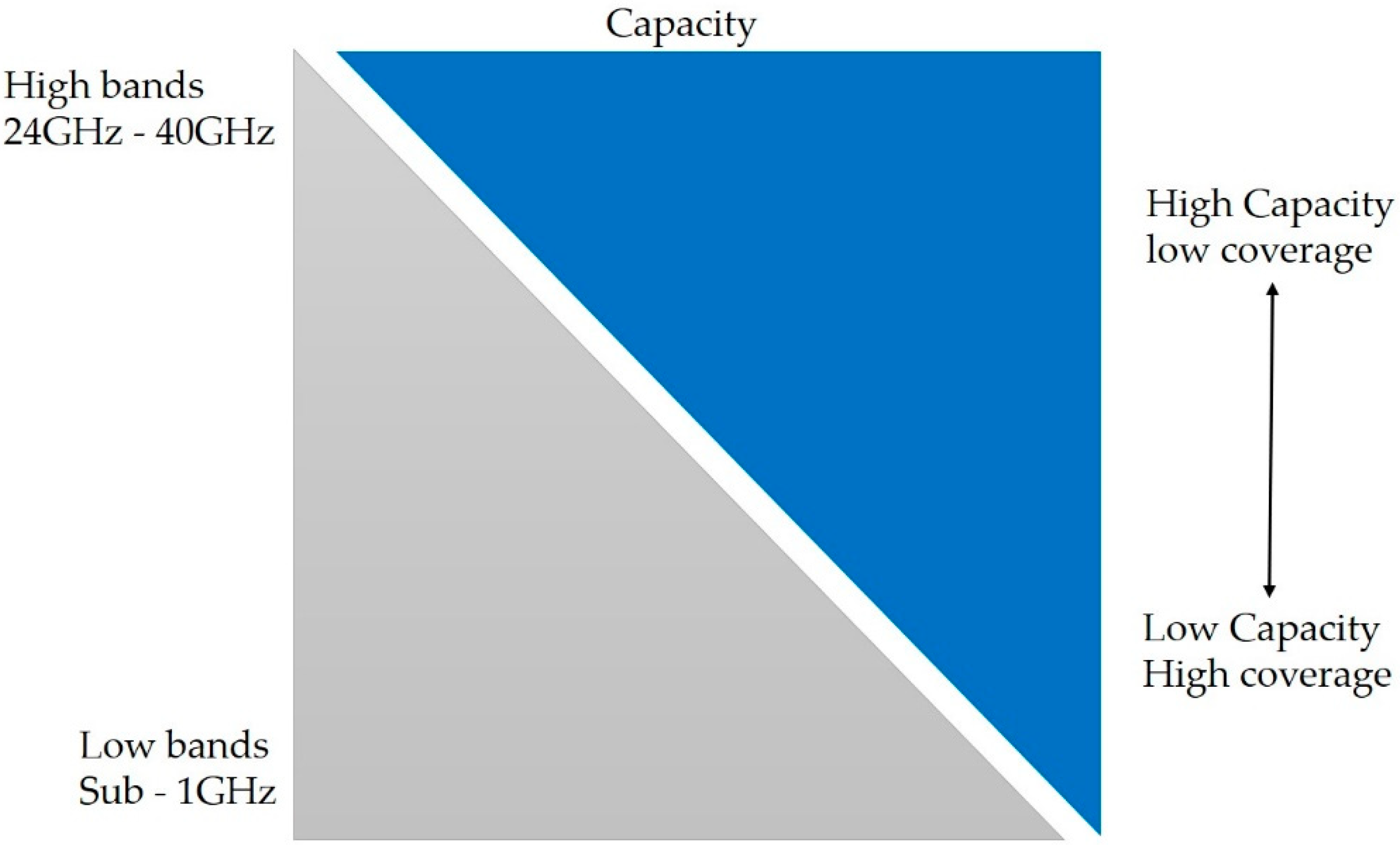

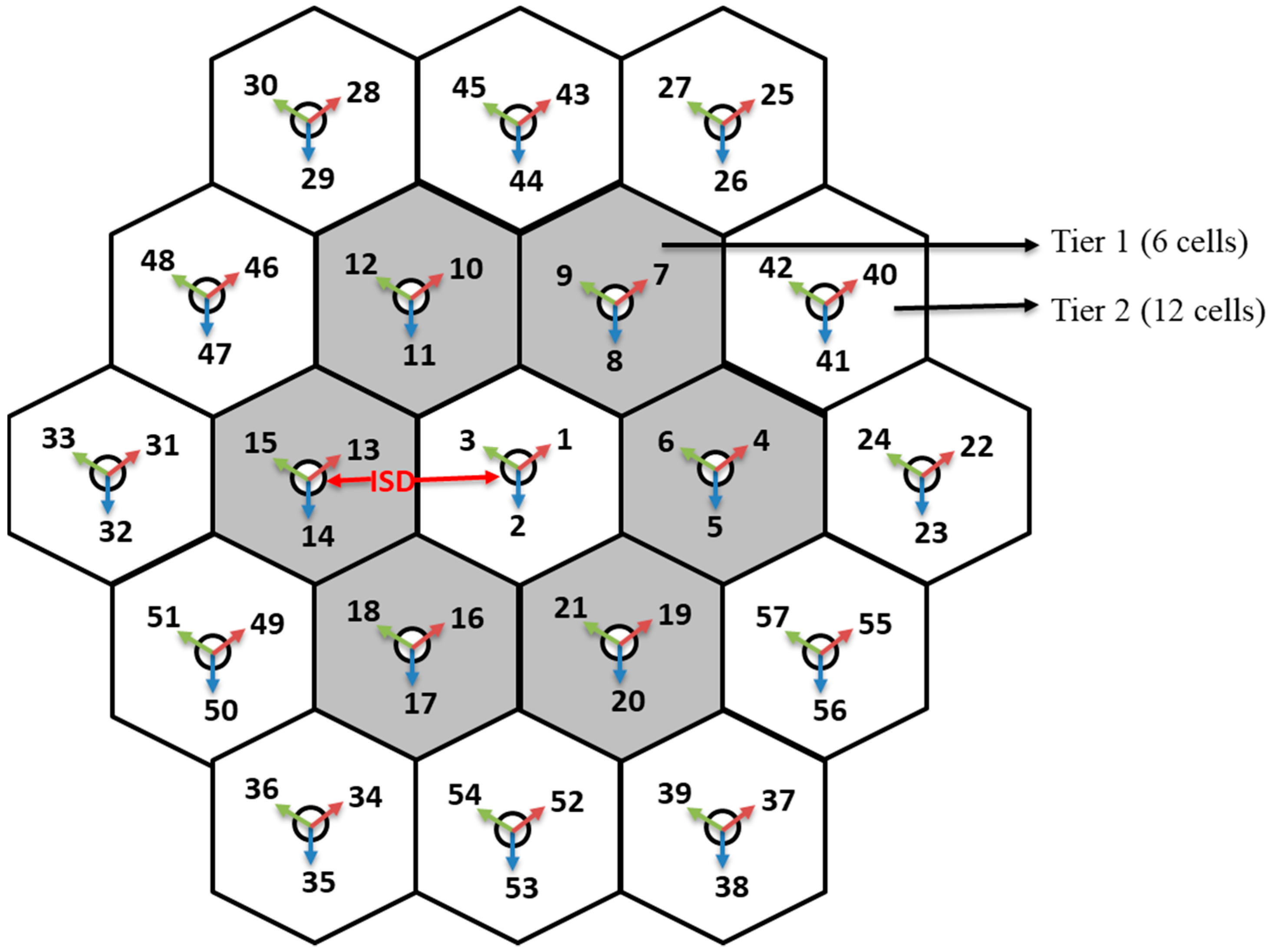





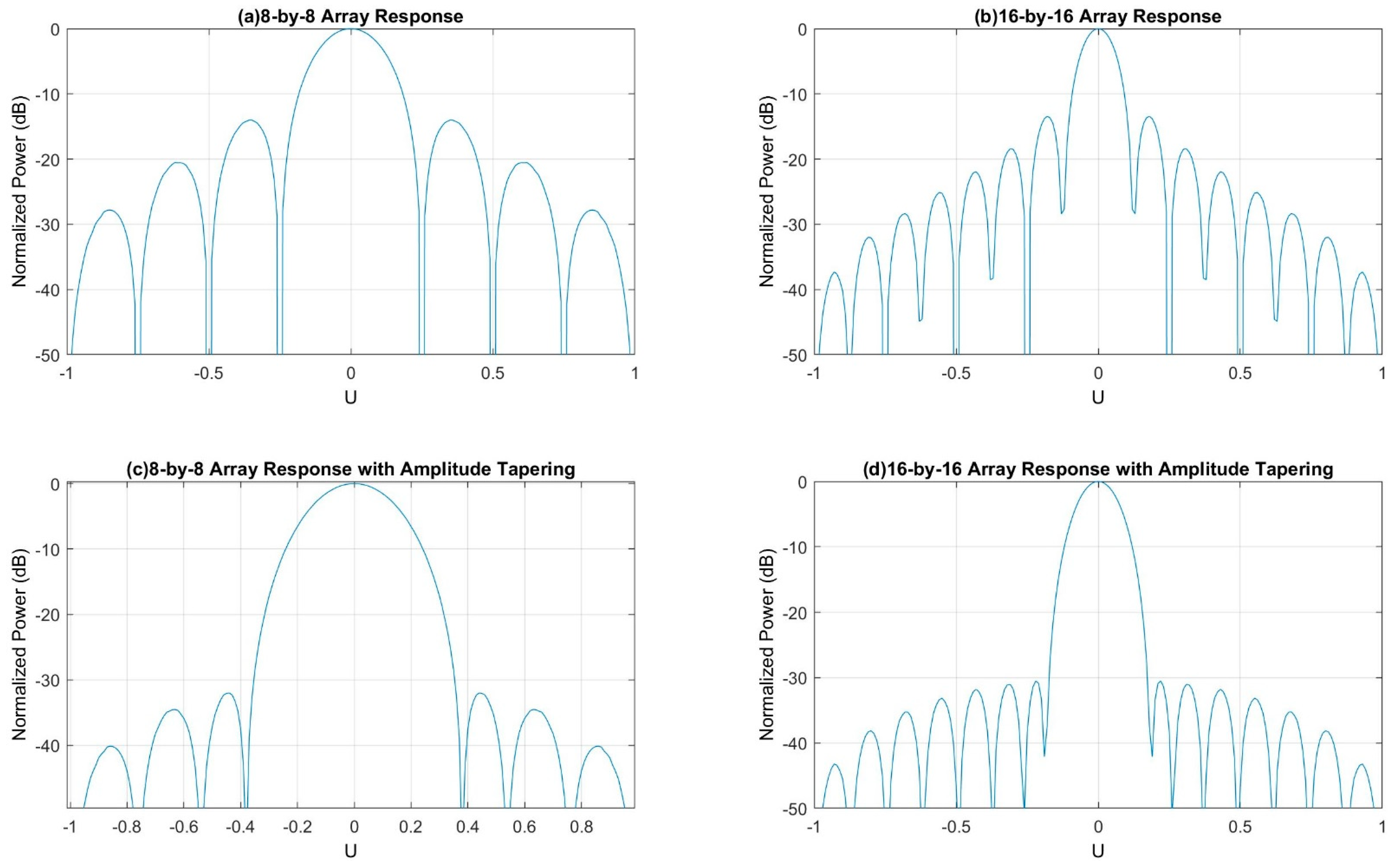
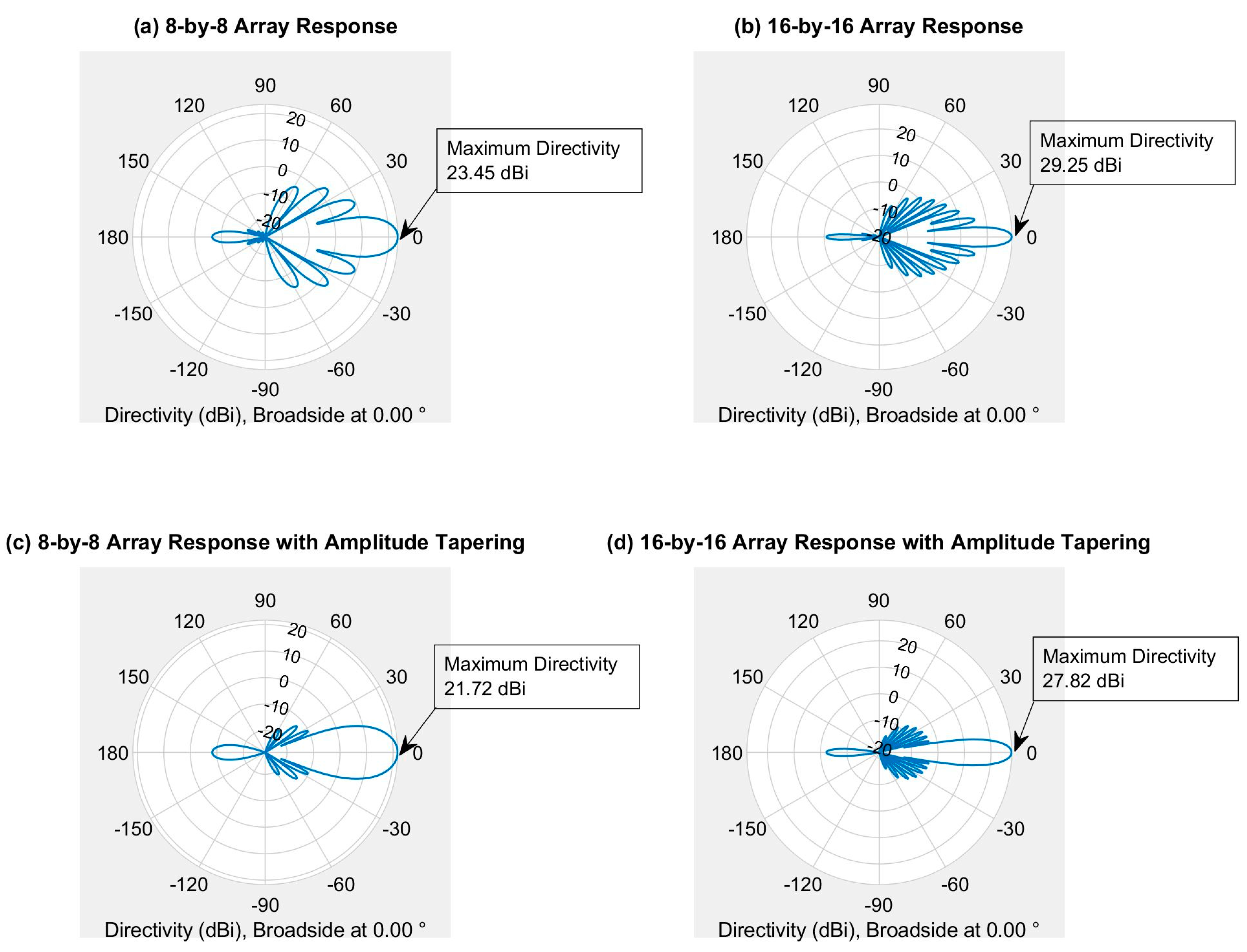


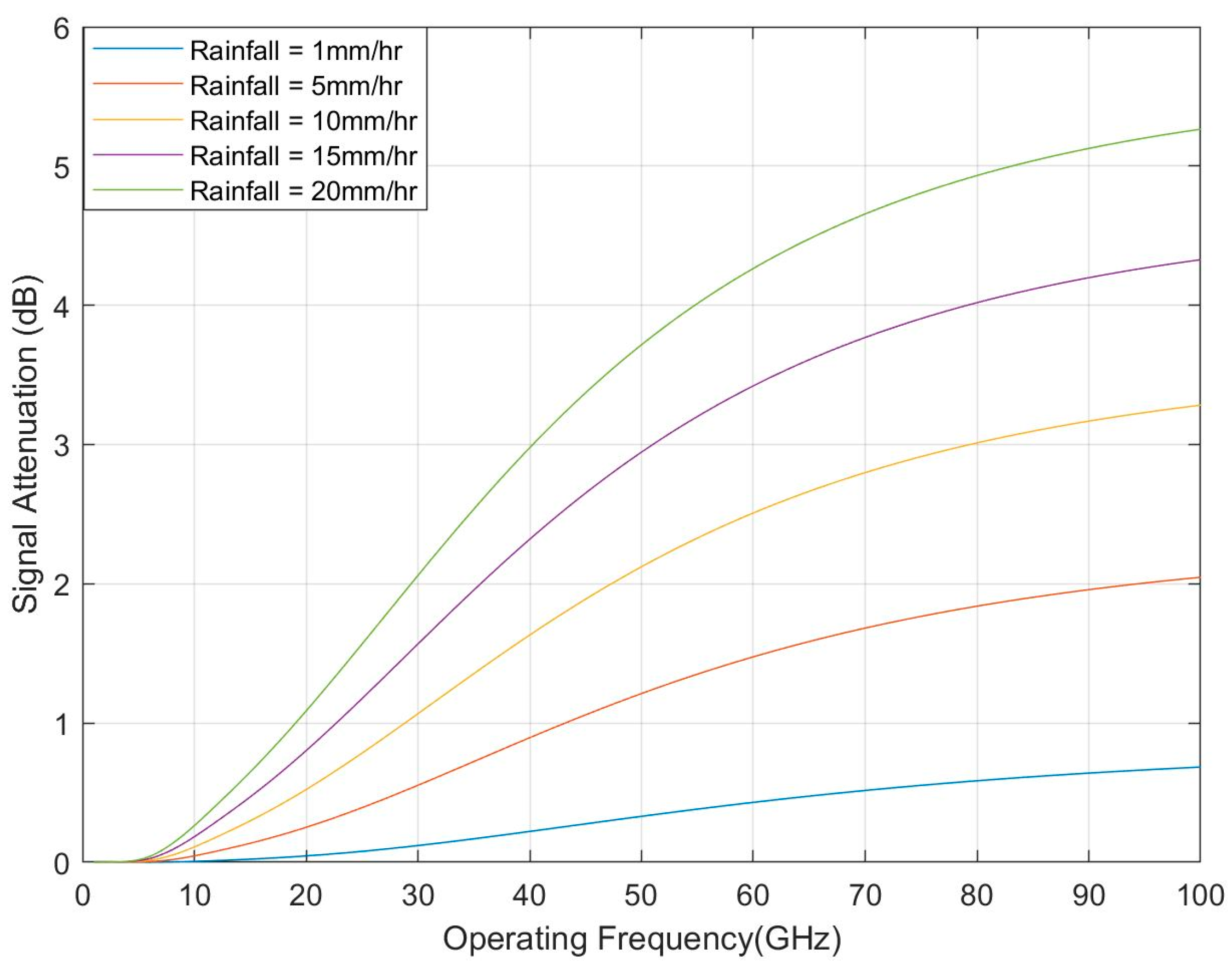

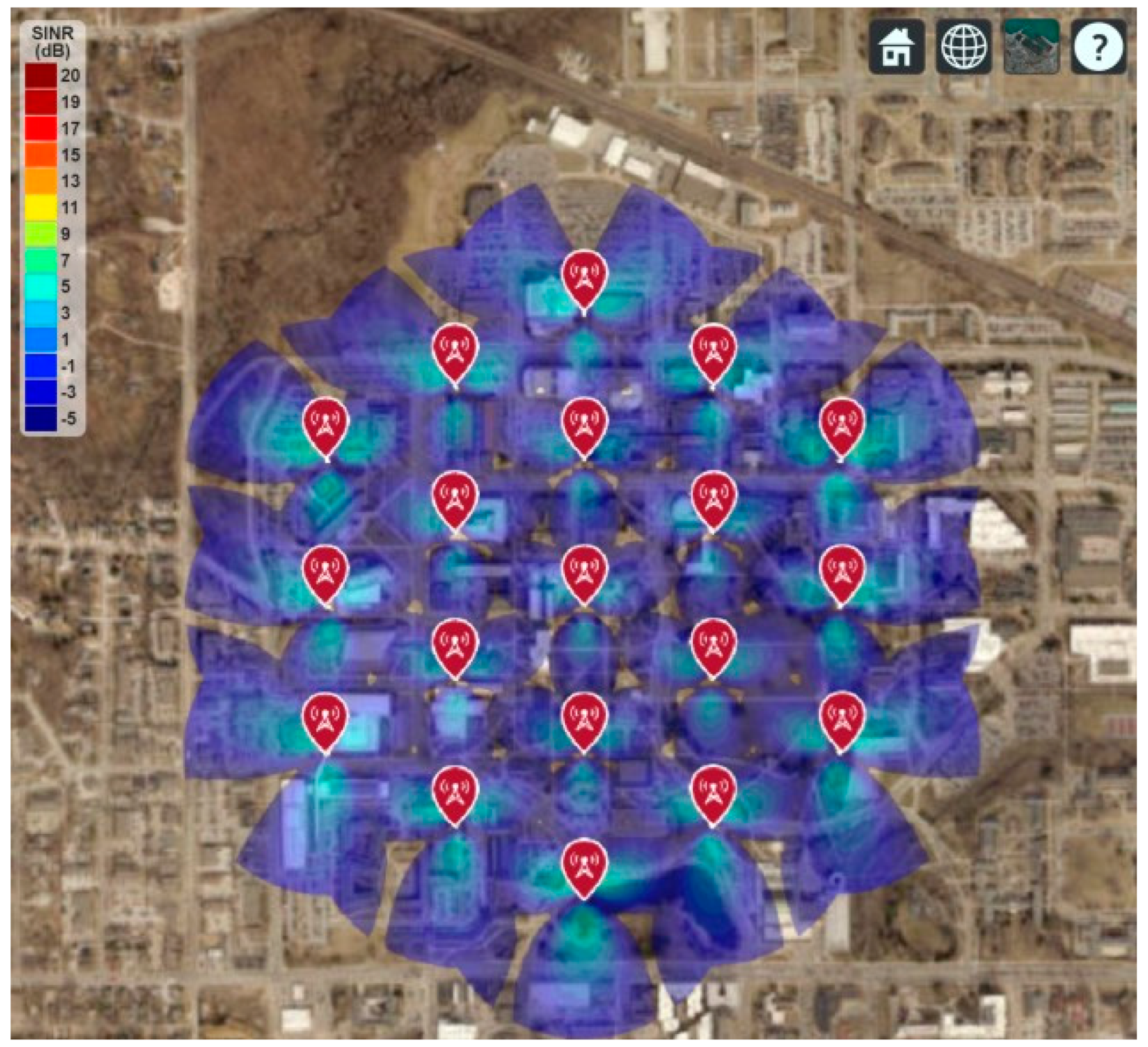

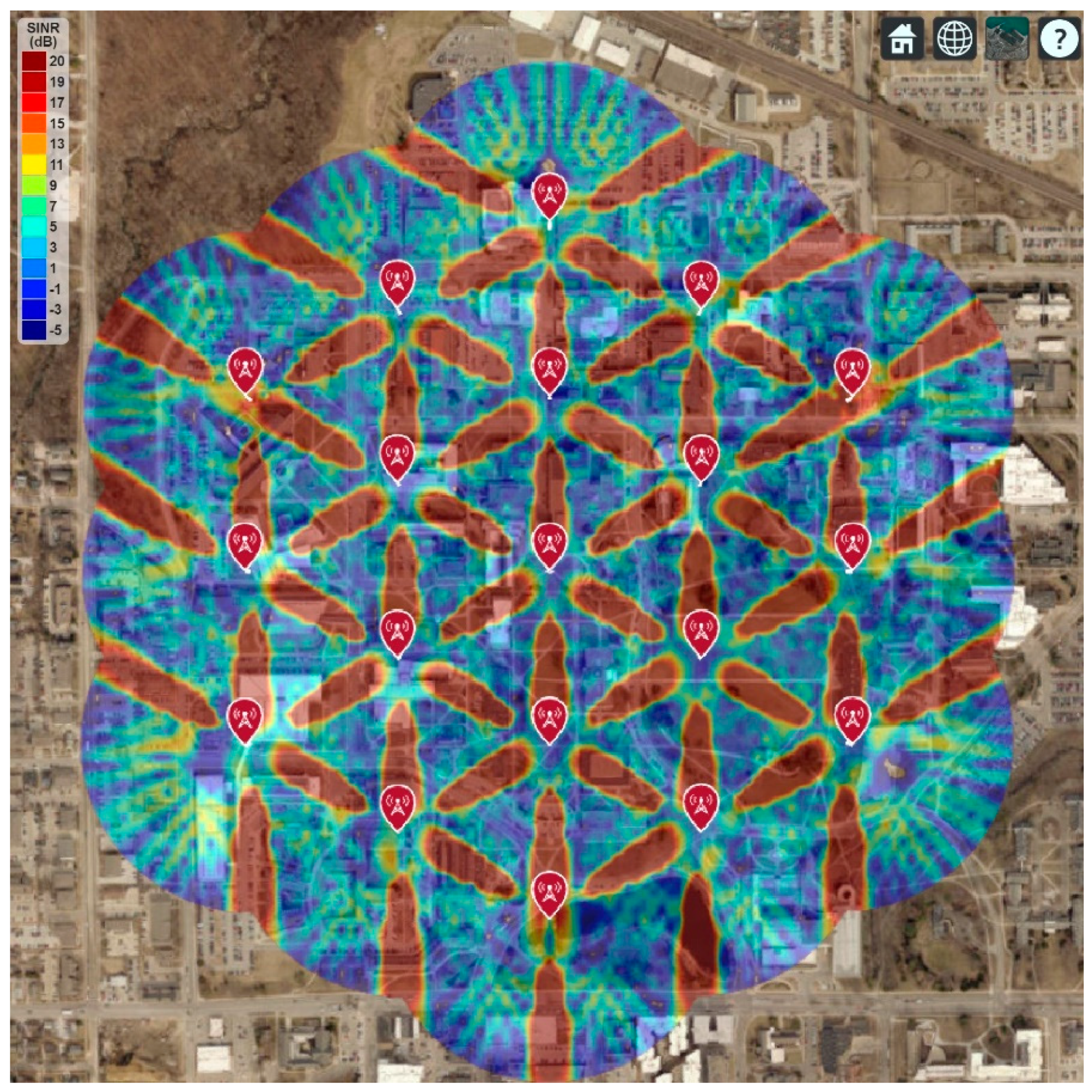
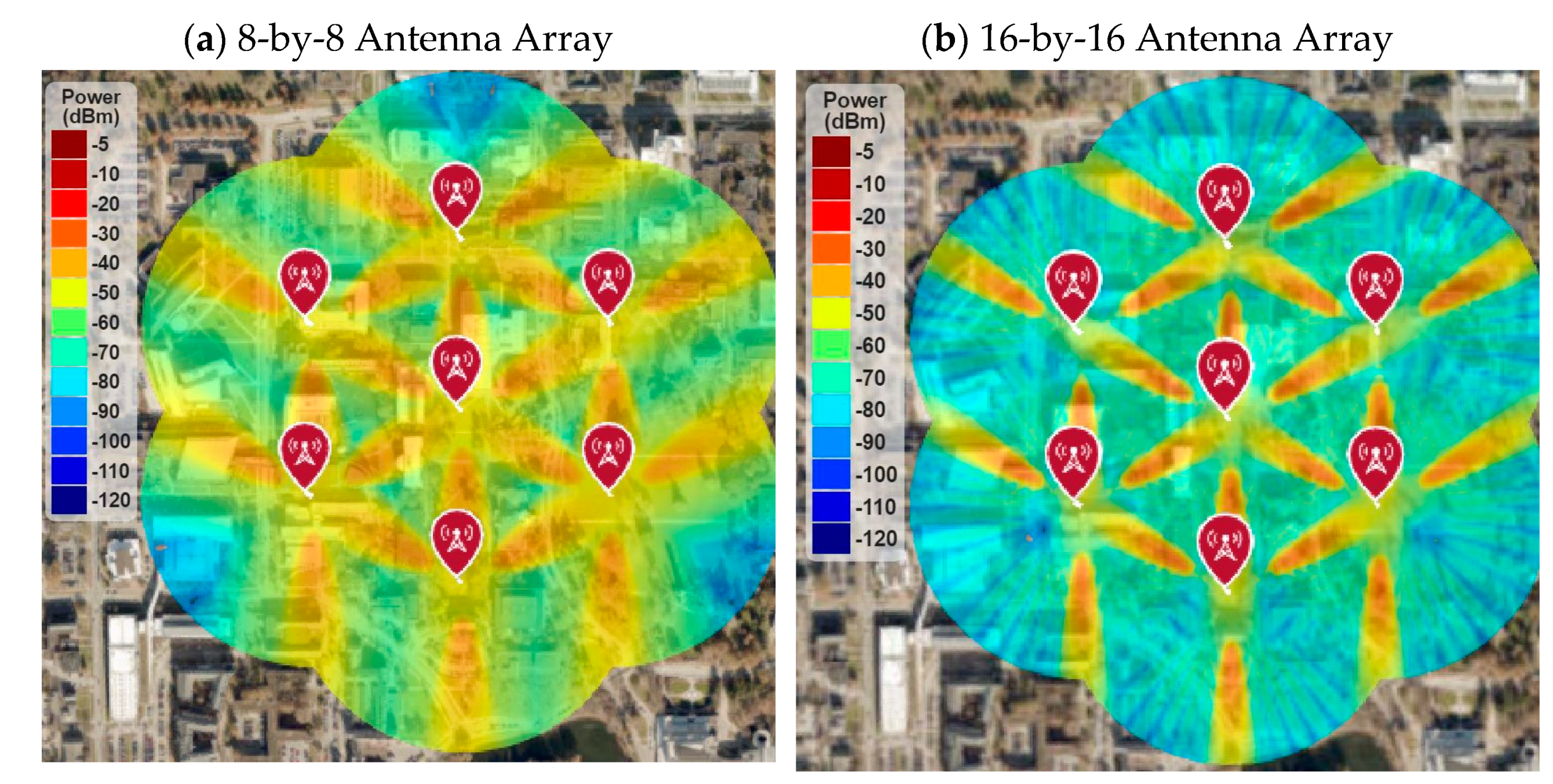
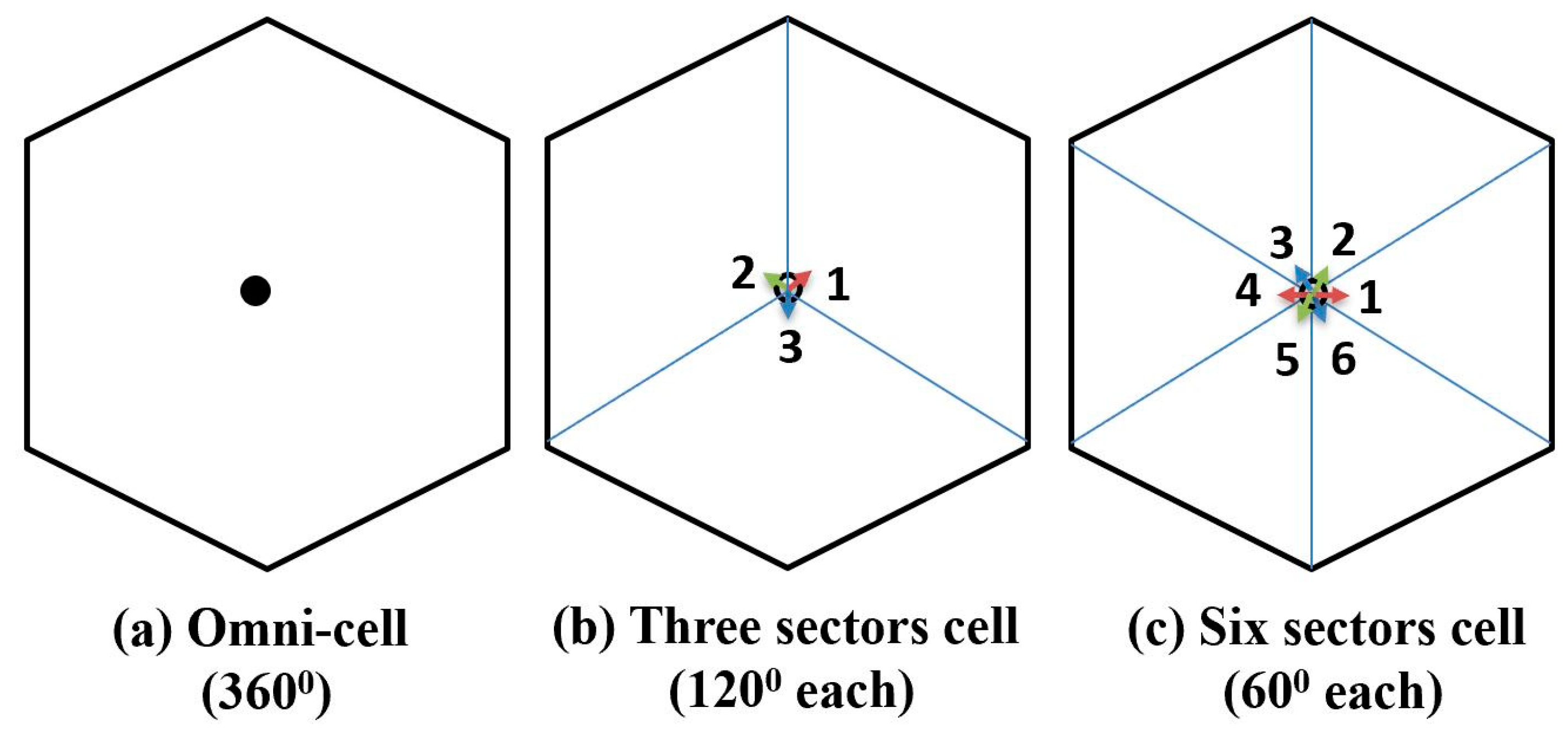
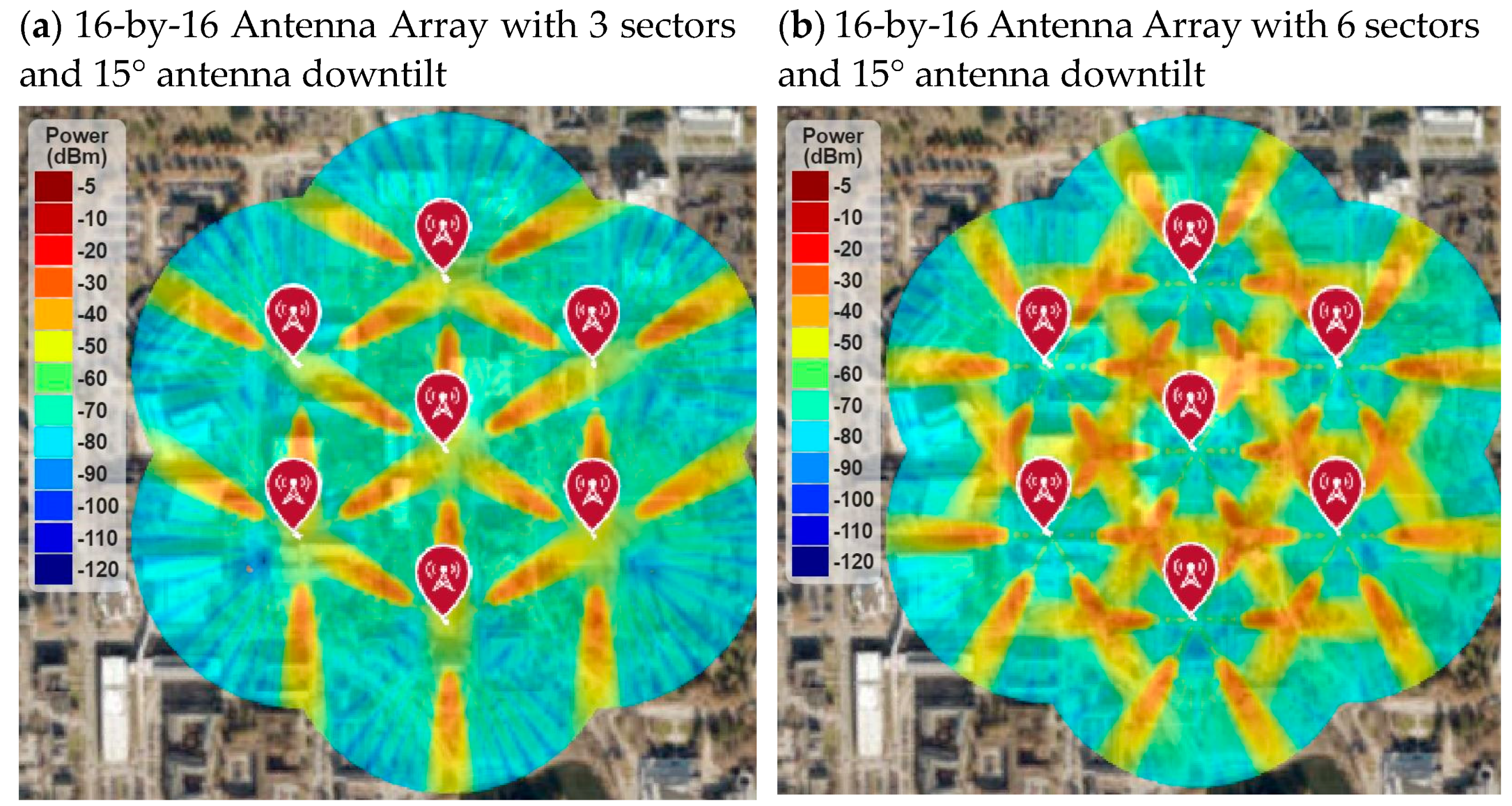

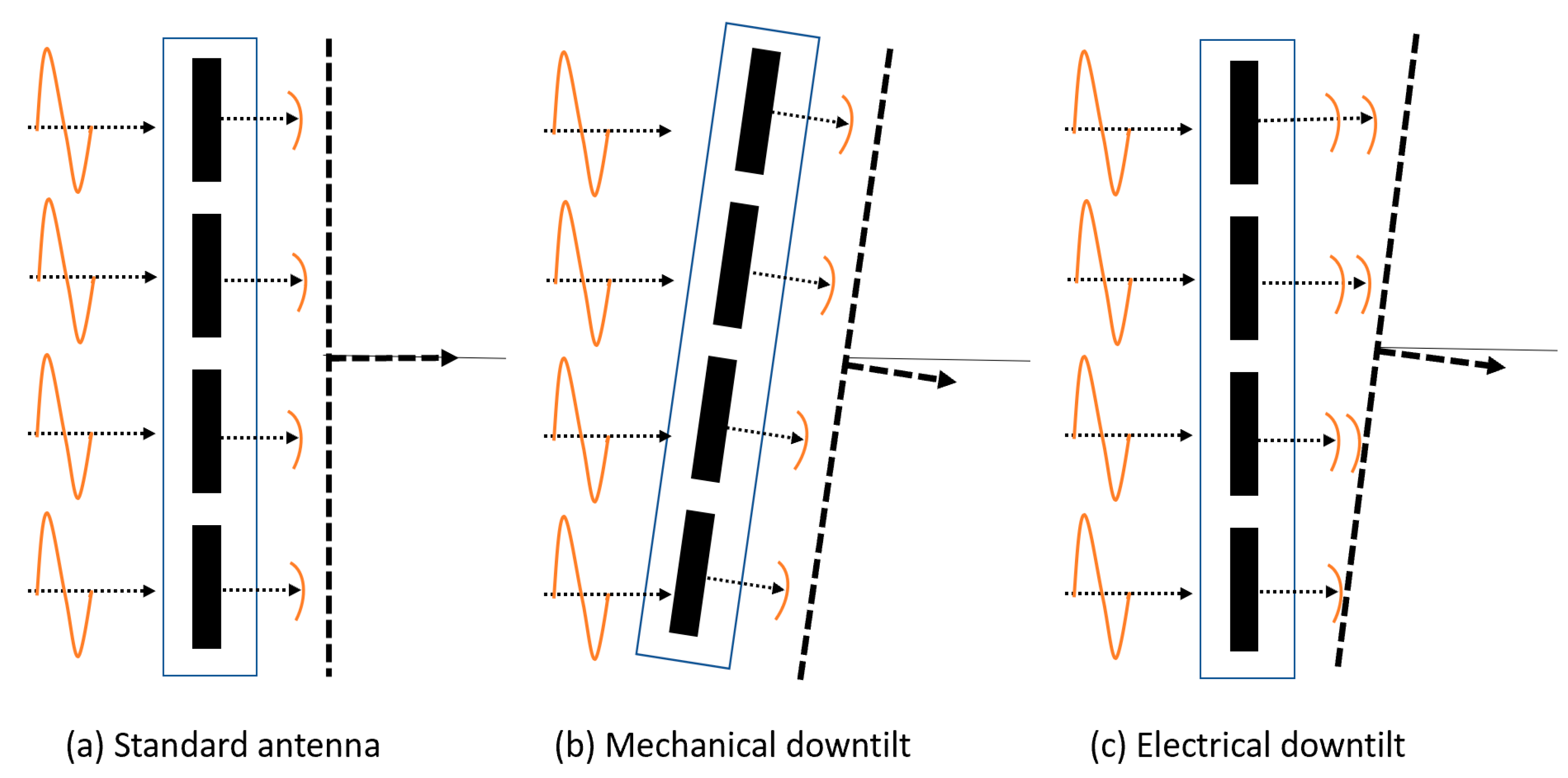
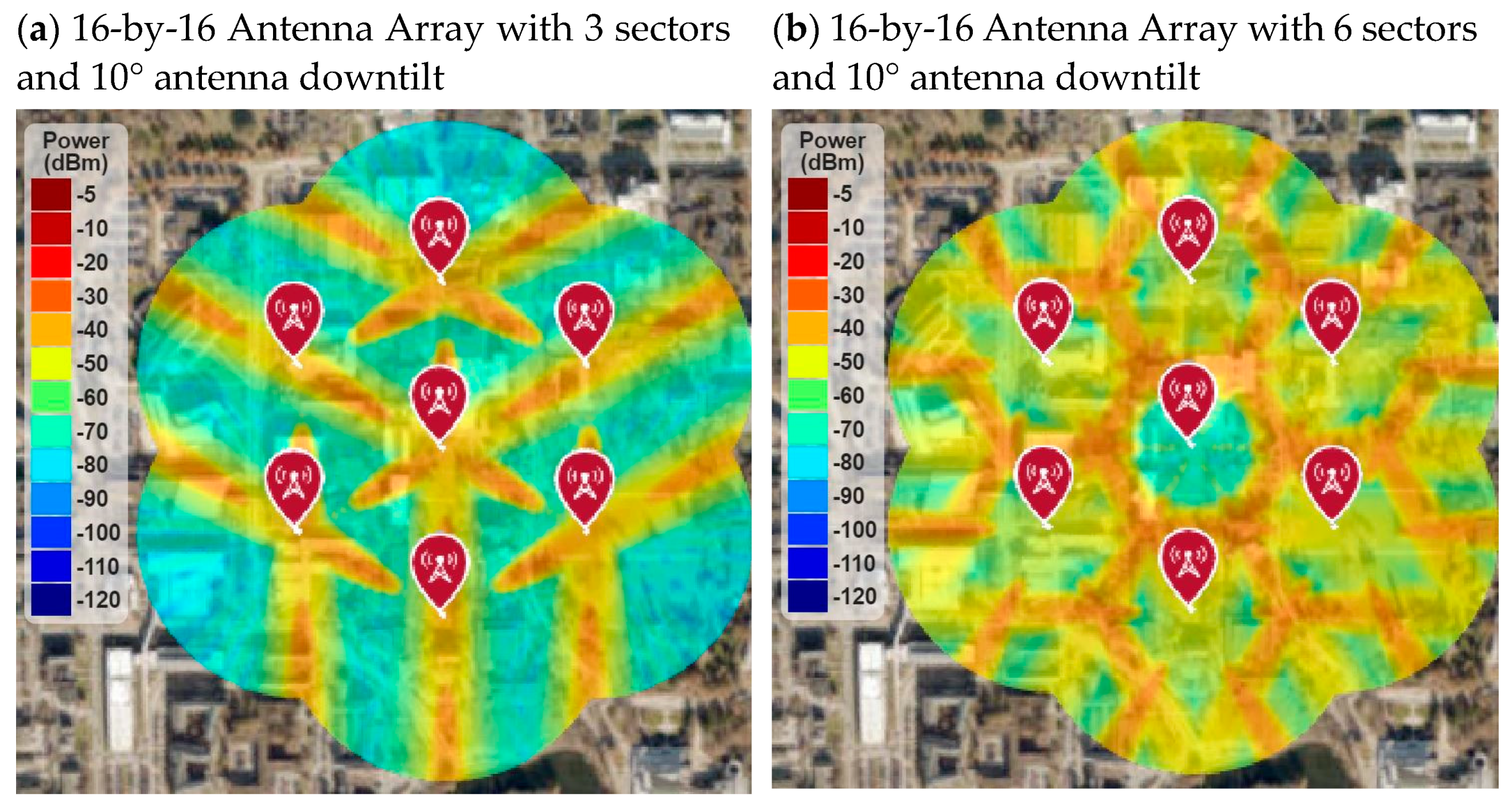


| Generation | Year | Primary Services | Key Differentiator |
|---|---|---|---|
| 5G | 2020s | Massive mobile broadband, massive Internet of Things (IoT), industrial automation | Digitalization of industry, ultra-low latency, ultra-high availability, ultra-speed, and ultra-reliability |
| 4G | 2010s | All 3G services and mobile video consumption with higher data speed | Faster broadband internet and lower latency |
| 3G | 2000s | Phone calls, messaging, mobile web browsing | Broadband internet and smartphones |
| 2G | 1990s | Mobile voice calls and messaging | Digital |
| 1G | 1980s | Analogue voice calls | Mobility |
| Parameters | Value |
|---|---|
| Operating Frequency | 30 GHz |
| Bandwidth | 80 MHz |
| BS Antenna height | 25 m |
| BS Transmit power | 40 dBm |
| BS Antenna gain | 10 dBi |
| BS Antenna noise figure | 7 dB |
| Receiver height | 1.5 m |
| Receiver noise figure | 7 dB |
| Receiver gain | 8 dBi |
| No. of cell sites | 19 |
| Inter-site distance | 200 m |
Publisher’s Note: MDPI stays neutral with regard to jurisdictional claims in published maps and institutional affiliations. |
© 2021 by the authors. Licensee MDPI, Basel, Switzerland. This article is an open access article distributed under the terms and conditions of the Creative Commons Attribution (CC BY) license (https://creativecommons.org/licenses/by/4.0/).
Share and Cite
Ahamed, M.M.; Faruque, S. 5G Network Coverage Planning and Analysis of the Deployment Challenges. Sensors 2021, 21, 6608. https://doi.org/10.3390/s21196608
Ahamed MM, Faruque S. 5G Network Coverage Planning and Analysis of the Deployment Challenges. Sensors. 2021; 21(19):6608. https://doi.org/10.3390/s21196608
Chicago/Turabian StyleAhamed, Md Maruf, and Saleh Faruque. 2021. "5G Network Coverage Planning and Analysis of the Deployment Challenges" Sensors 21, no. 19: 6608. https://doi.org/10.3390/s21196608
APA StyleAhamed, M. M., & Faruque, S. (2021). 5G Network Coverage Planning and Analysis of the Deployment Challenges. Sensors, 21(19), 6608. https://doi.org/10.3390/s21196608






